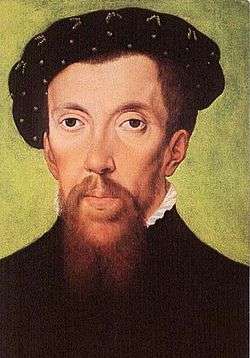Anthony Denny

Sir Anthony Denny (16 January 1501 – 10 September 1549) was a confidant of Henry VIII of England. Denny was the most prominent member of the Privy chamber in Henry's last years having, together with his brother-in-law John Gates, charge of the "dry stamp" of Henry's signature, and attended Henry on his deathbed. He also served as Groom of the Stool. He was a member of the reformist circle that offset the conservative religious influence of Bishop Gardiner. He was a wealthy man, having acquired manors and former religious sites through the Court of augmentations.[1] By 1548 he was keeper of Westminster Palace.[2]
Life
Anthony Denny was the second son of Sir Edmund Denny (d. 22 December 1520), a Baron of the Exchequer, by his second wife, Mary Troutbeck, the daughter and coheir of Robert Troutbeck of Bridge Trafford, Chester. He had an elder brother, Sir Thomas Denny, of How, Norfolk, who married Elizabeth Monoux, the daughter of Sir George Monoux, Lord Mayor of London, as well as two younger brothers and ten sisters.[3][4]
Denny was educated at St Paul's School and St John's College, Cambridge.[5] In 1547 he was elected knight of the shire (MP) for Hertfordshire.
Along with Edward Seymour, Earl of Hertford, John Dudley, Viscount Lisle and Sir William Paget, Denny helped to finalise Henry VIII's will upon his deathbed in 1547. Denny specifically argued to Henry on several occasions against the removal of Stephen Gardiner from the will. Denny was himself the man to tell Henry of his coming death, advising the old King "to prepare for his final agony". Denny's position gave him both the power to control who saw Henry in his last years (in which he spent excessive time in the Privy Chambers), and influence through his personal relationship with the ageing King. Along with Sir William Paget, the Principal Secretary, Denny is suspected of having fixed the choosing of the "Progressive" appeals, headed by Edward Seymour.
In 1525 Denny married Joan Champernowne, cousin to Katherine Ashley née Champernowne, the governess of the future Queen Elizabeth I. They had 12 children.[6] A son was Sir Edward Denny, Knight Banneret of Bishops Stortford 1547-1599, cousin to Walter Raleigh.
See also
Notes
- ↑ Hutchinson, Robert (2006): The Last Days of Henry VIII: Conspiracy, Treason and Heresy at the Court of the dying Tyrant Phoenix ISBN 0-7538-1936-8 pp. 152–159
- ↑ HMC, 7th report, More Molyneaux Loseley, 605b.
- ↑ Rye 1891, pp. 101-2.
- ↑ Nichols 1858, pp. 208-9.
- ↑ "Denny, Anthony (DNY500A)". A Cambridge Alumni Database. University of Cambridge.
- ↑ Hutchinson, Robert (2006): The Last Days of Henry VIII: Conspiracy, Treason and Heresy at the Court of the dying Tyrant Phoenix ISBN 0-7538-1936-8 p. 154
References
- Nichols, John Gough, ed. (1858). The Topographer and Genealogist III. London: John Bowyer Nichols and Sons. pp. 208–9. Retrieved 6 May 2013.
- Rye, Walter (1891). The Visitation of Norfolk. XXXII. London: Harleian Society. pp. 101–2. Retrieved 6 May 2013.
- Sil, Narasingha P. (2004). "Denny, Sir Anthony (1501–1549)". Oxford Dictionary of National Biography (online ed.). Oxford University Press. doi:10.1093/ref:odnb/7506. (Subscription or UK public library membership required.)
External links
- Sir Anthony Denny, Knight
- Sir Anthony Denny (1501–1549), Courtier to King Henry VIII: Sitter associated with 3 portraits (National Portrait Gallery)
|